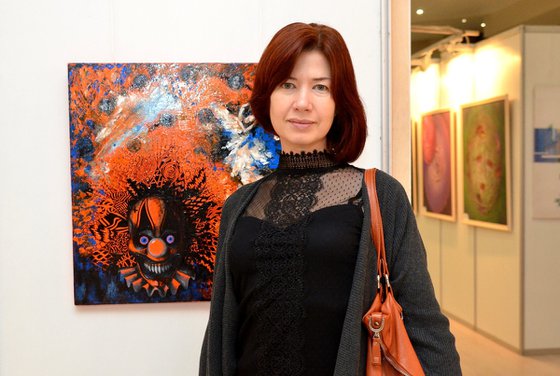Main Navigation
Original artwork description:
60*60cm, oil on cotton stretched canvas, 2018.
The artwork is signed on the back and accompanied with a certificate of authenticity. The canvas is stretched on a wooden frame and artwork is ready to hang. Framing is not required. The work is covered with a protective varnish layer.
"Danse Macabre" is the title of a symphonic poem by French composer Camille Saint-Saens, written in 1874. The composition is based on the poem of the poet Henri Cazalis with the ironic title “Equality, brotherhood”. The poem is based on the old superstition, according to which Death appears at midnight every year on Halloween. Death has the right to call the dead from their graves so that they dance for her while she plays her violin. "Danse Macabre", also called the Dance of Death, is a medieval allegory. At the basis of its content were ideas about the insignificance of human life, about the transitory nature of earthly goods and unhappiness, the equality of one and all before the face of death, equally inexorably carrying off the old man, the young man, and the newborn baby. Sometimes death is either a clever sharper who beats every partner, or a driver of a round dance, in which people of all ages, titles and states involuntarily participate, or a malevolent musician, forcing everyone to dance to the sounds of his pipe.
Materials used:
oil, canvas
Tags:
#abstract painting #skull #clown #orange and #birth #flame #death abstract #ornaments for #oil artwork #life danceDanse Macabre (Dance of Death) (2018) Oil painting
by Elena Soroka
1 Artist Reviews
£400.75 Sold
- Oil painting on Canvas
- One of a kind artwork
- Size: 60 x 60 x 2cm (unframed) / 60 x 60cm (actual image size)
- Ready to hang
- Signed on the front
- Style: Surrealistic
- Subject: People and portraits
Loading
Original artwork description
60*60cm, oil on cotton stretched canvas, 2018.
The artwork is signed on the back and accompanied with a certificate of authenticity. The canvas is stretched on a wooden frame and artwork is ready to hang. Framing is not required. The work is covered with a protective varnish layer.
"Danse Macabre" is the title of a symphonic poem by French composer Camille Saint-Saens, written in 1874. The composition is based on the poem of the poet Henri Cazalis with the ironic title “Equality, brotherhood”. The poem is based on the old superstition, according to which Death appears at midnight every year on Halloween. Death has the right to call the dead from their graves so that they dance for her while she plays her violin. "Danse Macabre", also called the Dance of Death, is a medieval allegory. At the basis of its content were ideas about the insignificance of human life, about the transitory nature of earthly goods and unhappiness, the equality of one and all before the face of death, equally inexorably carrying off the old man, the young man, and the newborn baby. Sometimes death is either a clever sharper who beats every partner, or a driver of a round dance, in which people of all ages, titles and states involuntarily participate, or a malevolent musician, forcing everyone to dance to the sounds of his pipe.
Materials used:
oil, canvas
Tags:
#abstract painting #skull #clown #orange and #birth #flame #death abstract #ornaments for #oil artwork #life dance14 day money back guaranteeLearn more









